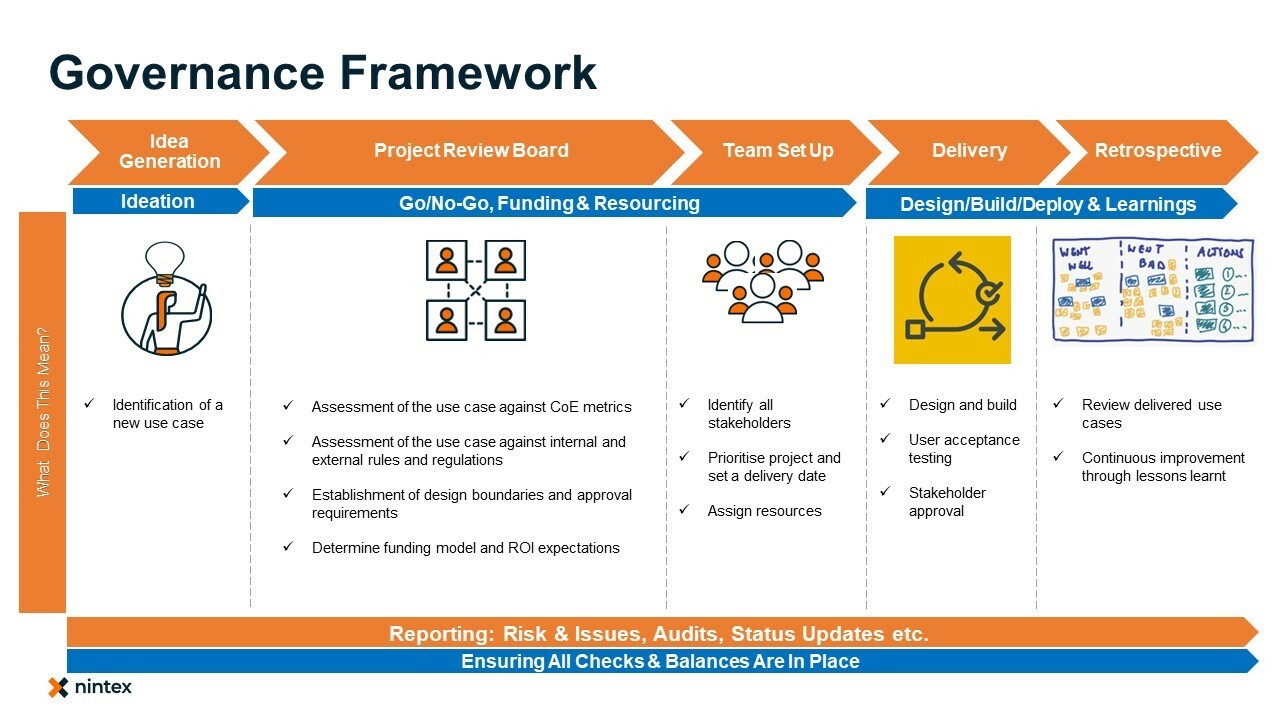Last week we went through the structure of your Center of Excellence (CoE) setting out the need for an Executive Sponsor and the necessary staffing required to be successful. Now we will examine why Governance important for a successful and effective CoE.
If you add every idea immediately into your book of work, you are bound to create solutions that really shouldn’t be created; either because doing so would breach internal or external rules/ regulations or simply would not be a valuable use of your CoE’s resources. To avoid this, you need to establish a governance framework. This governance framework is structured to identify opportunities, review those opportunities, resources the development and delivery of a solution and conduct a retrospective of each. Let's walk through each stage.

Idea Generation:
At this stage there is outreach to teams, business units, individuals soliciting input. Often a campaign is initiated with a moniker of "transformation, optimization, continuous improvement" that will facilitate and support this idea generation. Who better to hear from than team members that face challenges and have firsthand experience to draw from?? In addition to this ‘bottom-up’ style of idea generation, the CoE can of course identify ideas and use cases itself by suggesting to the Line of Business (LoB) where it believes that it can add value.
Project Review Board:
Once identified, before the idea can be built it will need to be assessed by a Project Review Board.
The first mission of the Project Review Board will be to make a go/ no-go decision which involves assessing the idea from two perspectives:
- Does this idea align with the objectives of the CoE, and will it deliver enough ROI to justify the allocation of resources?
- Will delivering this idea breach any internal or external rules and regulations?
Once an idea has deemed to be suitable and has been given the green light, the Project Review Board will need to define the boundaries of what will be built, secure any funding necessary, and establish how ROI will be measured.
Team Set up:
Next up, the idea will have to be prioritized (with a target delivery date established) to ensure that low value/ low impact ideas don’t take resources away from developing high value/ high impact ideas. Once prioritized, the team who will be involved in building the idea will be set up with roles and responsibilities established.
Delivery:
At the Delivery stage our team has been funded and resourced with the necessary expertise and tools to design and build high grade solutions. Corporate development strategies are applied, user acceptance testing is done, and our Stakeholder approval process is conducted to validate that all internal and external metrics are satisfied.
Retrospective:
As a part of the Governance cycle, it is imperative you have a retrospective of your solutions. Establishing a cadence for reviewing these solutions allows for opportunities for continuous improvement as well as time to determine if the solution is meeting expectations. It isn't unusual to have a solution move back into the Design/Build stage for fine tuning.
Underlying this Governance Framework is the ability to report on risks and issues, conducting audits to ensure budget and time frames are adhered to, with scheduled status updates. Reporting allows Stakeholders to review progress of solutions and make decisions based on real time data.
We can take a deep breath now that all our ideas have been designed, developed and deployed and we can pat each other on the back. But how do we know if we have been successful? Next week we discuss ways to measure the success of your CoE.


